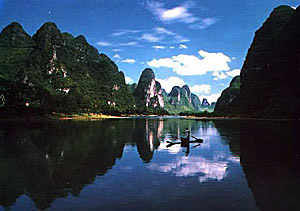
Guangxi (simplified Chinese: 广西) is an autonomous region (Guangxi Zhuang Autonomous Region) of the People's Republic of China, created specifically for the Zhuang people.
Its location in southern China, along its border with Vietnam, and mountainous terrain, has made it one of the border frontiers of Chinese civilization. Even into the 20th century it was considered an open, wild territory. The current name "Guang" itself means "expanse", and has been associated with the region since the creation of Guang Prefecture in 226 AD. It was given provincial level status during the Yuan Dynasty and in 1949 was reformed as one of China's five minority autonomous regions.
The abbreviation of the province is 桂 (Gui), which comes from the city of Guilin, the former capital, center of much of Guangxi's culture, politics, and history, and currently a major city in the autonomous region.
Located in the southern part of the country, Guangxi is bordered by Yunnan to the west, Guizhou to the north, Hunan to the northeast, and Guangdong to the southeast. It is also bounded by Vietnam in the southwest and the Gulf of Tonkin in the south.
Guangxi is a mountainous region. The Nanling Mountains are found in the northeast border, with the Yuecheng Mountains (越城岭) and Haiyang Mountains (海洋山) being its shorter branching ridges. Nearer to the center of the region are the Dayao Mountains (大瑶山) and the Daming Mountains (大明山). To the north there are the Duyao Mountains (都阳山) and the Fenghuang Mountains (凤凰山), while on the southeast border there are the Yunkai Mountains (云开大山). The highest point is Mount Mao'er (猫儿山) located in the Yuecheng Mountains, at 2141 m. "Guangxi" and neighbouring Guangdong literally mean "Guang West" and "Guang East". Together, Guangdong and Guangxi are called the "Two Guangs" (两广, Liǎngguǎng, 兩廣 loeng gwong). Its culture and language are reflected in this. Though now associated with the Zhuang ethnic minority, Guangxi's culture traditionally has had a close connection with the Cantonese. Cantonese culture and language followed the Xi River valley from Guangdong and is still predominate in the eastern half of Guangxi today. Outside of this area there is a huge variety of ethnicities and language groups represented.
Guangxi is known for its ethno-linguistic diversity. In the capital of Nanning, for example, four dialect-languages are spoken locally: Southwestern Mandarin, Cantonese, Pinghua, and Zhuang.
The major tourist attraction of Guangxi is Guilin, a town famed across China and the world for its spectacular setting by the Lijiang River (Li River) amongst severe karst peaks. It also used to be the capital of Guangxi, and Jingjiang Princes City, the old princes residence, is open to the public. South of Guilin down the river is the town of Yangshuo, which has become a favourite destination for foreign tourists, particularly backpackers.
Ethnic minorities native to Guangxi, such as the Zhuang and Dong, are also interesting for tourists. The northern part of the province, bordering with Guizhou, is home to the Longsheng Rice Terraces, said to be some of the steepest in the world. Nearby is Sanjiang Dong Autonomous County.









0 comments:
Post a Comment